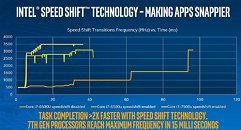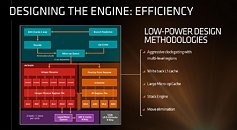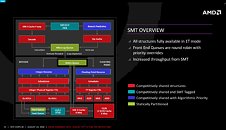Tuesday, September 6th 2016

SMT and Power Management Behind "Kaby Lake" and "ZEN" Windows 10 Restrictions
Microsoft recently sparked a stir when it was reported that the company will support upcoming CPU architectures by Intel and AMD only on Windows 10, with the keyword being "support" and not "compatibility." This means that Microsoft will offer customer-support and likely serve updates to Intel "Kaby Lake" and AMD "ZEN" machines only running Windows 10 (and its enterprise variant Windows Server 2016, based on the NT 10 kernel), and not older versions of Windows. The processors themselves are compatible with any x86 operating system, Windows or *nix, 32-bit or 64-bit. HotHardware dug out the likely causes of this decision.
Apparently, new power-management and SMT features are behind the decision. With its "Kaby Lake" microarchitecture, Intel is introducing a new power-management feature called Speed Shift Technology. This lets the processor adjust its clock-speed to match processing loads at response time of 15 ms. This likely requires OS-level hooks, so the on-die power-management components can poll for processing loads and accordingly raise or lower clock-speeds 66.66 times each second, at no CPU cost. In its ZEN microarchitecture reveal, AMD too spoke about fine-grained, multi-domain clock-gating (≠ power-gating) on its "ZEN" based processors, such as "Summit Ridge."AMD "ZEN" processors introduce simultaneous multi-threading, a feature that exposes each physical core as two logical CPUs to the OS, for better utilization of on-die resources. Intel's implementation of SMT is the HyperThreading Technology (HTT), and has been around for over a decade. AMD's SMT implementation isn't identical to that of HyperThreading, with the two threads on a CPU competing for resources in a method unique to AMD. This can't work without the OS kernel and scheduler being aware of the method. You'll remember that Microsoft had to update the kernel and scheduler of Windows 7 in a similar way, to optimize it for "Bulldozer."
These, HotHardware argues, could be the likely reasons why Microsoft is limiting support for the new CPU microarchitectures to Windows 10.
Source:
HotHardware
Apparently, new power-management and SMT features are behind the decision. With its "Kaby Lake" microarchitecture, Intel is introducing a new power-management feature called Speed Shift Technology. This lets the processor adjust its clock-speed to match processing loads at response time of 15 ms. This likely requires OS-level hooks, so the on-die power-management components can poll for processing loads and accordingly raise or lower clock-speeds 66.66 times each second, at no CPU cost. In its ZEN microarchitecture reveal, AMD too spoke about fine-grained, multi-domain clock-gating (≠ power-gating) on its "ZEN" based processors, such as "Summit Ridge."AMD "ZEN" processors introduce simultaneous multi-threading, a feature that exposes each physical core as two logical CPUs to the OS, for better utilization of on-die resources. Intel's implementation of SMT is the HyperThreading Technology (HTT), and has been around for over a decade. AMD's SMT implementation isn't identical to that of HyperThreading, with the two threads on a CPU competing for resources in a method unique to AMD. This can't work without the OS kernel and scheduler being aware of the method. You'll remember that Microsoft had to update the kernel and scheduler of Windows 7 in a similar way, to optimize it for "Bulldozer."
These, HotHardware argues, could be the likely reasons why Microsoft is limiting support for the new CPU microarchitectures to Windows 10.



57 Comments on SMT and Power Management Behind "Kaby Lake" and "ZEN" Windows 10 Restrictions
As Most Apps are optimised already for SMT ( thanks to Intel ), it's only a matter of OS optimise now for the new architecture which I suppose is different than Intel implementation of the original SMT, maybe few changes for applications also to benefit more from AMD's architecture and maybe also using AMD's new instructions ( which BTW I don't know what the use of these new ones )
Because I do not play on batteries and consumption is not so crazy , such as on 4. GPU does not bother and each generation got consumption improved.
-shall i understand that win10 already could support new cpu arch?-i think no as when launched(July 2015 but surfaced Oct 2014 as beta test) amd didn't had the zen...
-this mean M$ will issue an OS update for this SMT?- yes
-could they make this update for older OS? -yes
-will they do?- no
why? - is another way to force implementation of win10....
See: www.anandtech.com/show/9751/examining-intel-skylake-speed-shift-more-responsive-processors
Older ones are fine with that they have. Whatever it may be. Use linux and live.
Those are good ideas and are helping with progress. There is no reason to support old code for M$. Take it or leave it.
On the other hand, it's not exactly a joy giving up an OS you're comfortable with, just to be able to use that new CPU. Imagine what this does to companies having hundreds of stations. They get the new OS for free, but still have to do some retraining.
Or just turn off HTT/SMT?
Edit: I'm not even sure you can get extended support (i.e. security patches) as a home user.
"End of sales
End of sales refers to the date when a particular version of Windows is no longer shipped to retailers or Original Equipment Manufacturers (OEMs). Examples of OEMS are Dell and Toshiba—PC manufacturers who often preinstall Windows software.
This table gives end of sales dates for specific Windows operating systems.
Client operating systems and updates Date of general availability Retail software end of sales* End of sales for PCs with Windows preinstalled
Windows XP December 31, 2001 June 30, 2008 October 22, 2010
Windows Vista January 30, 2007 October 22, 2010 October 22, 2011
Windows 7 Home Basic, Home Premium, Ultimate October 22, 2009 October 31, 2013 October 31, 2014
Windows 7 Professional October 22, 2009 October 31, 2013 October 31, 2016
Windows 8 October 26, 2012 October 31, 2014 June 30, 2016
Windows 8.1 October 18, 2013 September 1, 2015 October 31, 2016"
extended support must provide all enhancements for specific sold hardware ;for sure these hardware won't have new gen cpu; point is you can't say one OS is obsolete once you still sell it....
To not rely on the Hardware-Solutions of your own engineers, OMG.
AMD i hope you did not make the same mistake twice !!!